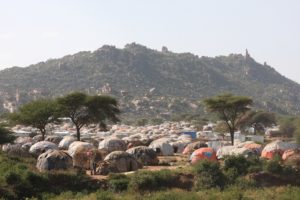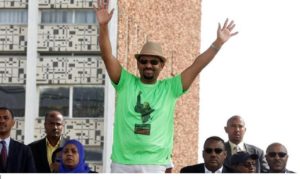THE INTERSECTIONALITY BETWEEN HATE NARRATIVE AND MASSACRE: THE ETHIOPIAN CASE

By Faisal Roble
The alarming rate of massacre carried out by marauding Oromos, consisting of paramilitary troops, vigilante gangs glorified by Oromo politicians as nationalist forces, and peasants armed with machetes, who viciously attack Somalis villages, offers a tell-tale of a typical ethnic genocide.
Actions of genocide are informed and precede by political narratives. To understand the intersectionality between genocide, or in the Somali Ethiopian case massacre, we need to look at the Ethiopian case within the context of other experiences.

In mid-May, 2018, I took my son to the Museum of Jewish Tolerance in Los Angeles. Despite my younger son’s piercing juvenile question of why only Jewish experience, and why not an African American Museum of tolerance commemorating the millions of Africans killed in the tracking of slaves along the Atlantic Ocean, learning how a sophisticated xenophobic narrative preceded the 1940s German Jew genocide was an invaluable lesson.
In retrospect, the visit I paid to the Museum of tolerance in Los Angeles prepared me for two things: it prepared me how to identify the calm before the storm and the signs of impending massacres. The other thing I gained is that massacre could happen in any society, and it is happening to mine.
An impressive recreation of the scenes that preceded the Jewish genocide in Germany has a lot of resemblance with what has transpired in Moyale and Tule-Guuleed in the hands of Somalis by Oromos.
The Museum recreated conversations, say at high-end restaurants in Bon, Berlin, Hamburg, and elsewhere, where a German elites tell their frightened Jewish friends over dinner not to worry about radical radio talk shows and vigilante songs that call for the liquation of Jews. But the fear of Jews elites who often married or socialized with high class Germans intensified as calls for anti-Jew propaganda became common place in daily talk shows.
As things quickly deteriorated, Jews residents found themselves helpless and exposed to angry and mis-agitated Jews who were thirsty for blood. Soon, every hater German had a license to identify, rob, raid properties and burn them, or kill people of Jewish background.

Here is a parallel experience that has transpired in Ethiopia since Oromo nationalist broke the bounds of law and order. A group of Oromo youth called Qeero, the political base of PM Abiy, has been agitated and mis-educated that Somalis are their number one enemy. Songs have been developed to this end. False history have been developed in order to justify land grabbing by angry Oromo mob.
A combined false history, agitation and selecting Somalis as the enemy fanned fear in the hearts of Somalis while Oromos gotten bold, brazen, with unflinching mind of massacre.
The crescendo of the calls and propaganda to massacre Somalis was reached in September, 2017, a few months leading to Abiy’s premiership. In a place called Awadey, located inside Oromia region, about 45 Somali civilians were slaughtered by the combined forces of OPDO regional forces, Qeero vigilante groups, and angry civilians drunk with hate towards Somalis. The songs of war and mayhem were being chanted by the killers. Since then, a massive ethnic cleaning of Somalis which has taken a new height since Abiy became the PM has been set in motion.
If that was not enough, the Qeero and Oromo’s xenophobic ideology has been fed by Oromo nationalist who reside in the West, Minneapolis in particular, which beamed hate message to Oromo youth back home. Not only did this hate narrative encourage Oromos to threaten other ethnic groups in the country, but also helped propelled PM Abiy Ahmed into the premiership in April 2018.
The new PM quickly showed his commitment to Oromo supremacy and quickly consolidated power in the hands of Oromos. He brought on to his inner circle extremist Oromos whose hands are tainted with the blood of Somalis, Amhara, Afars, and Sidamas.
On July 14, 2018, PM Abiy Ahmed hosted President Isaias Afework of Eretria and his large delegation as part of a timely rapprochement and peace deal of the two countries. The two sides brought to an end a conflict that last for twenty years and consumed 78,000 lives on both sides.
Following a huge fanfare and a ceremonial welcome to Isaias, a historic display of Oromo supremacy in Ethiopia where about 2,000 traditional horsemen welcomed Isaias Afework at Bole International Airport, the Eritrean delegation was taken to Awasa, only 100 miles to the south of Addis Ababa.
On the night of July 14, a huge dinner was thrown for the Eritrean delegation. Every ethnic group in Ethiopia was handsomely represented by high ranking delegates. There was only one Somali official, Ahmed Shide, Minister for Information. Even the regional president of the Somali zone was not invited.
What had transpired at the dinner represented the climax of the massacre of a hostile narrative against Somalis. A popular Qeero singer was invited to entertain PM Abiy and his guests. That sing unleashed a hate song which served as dagger into the hearts of besieged Somalis throughout the region occupied by Ethiopia. The Oromo war song calls for liquidating Somalis that stretch from Moyale to Chinacsani, a Somali city illegally occupied by OPDO and only 25 miles to the northwest of Jigjiga.
On the multiple screens of televisions across Addis Ababa, it was obvious that PM Abiy and his Oromo colleagues have been depicted with gleaming approval of the message in the song. People at the national dinner reception cheered and chanted. Clouds of war seemed to have engulfed the dinner hallway.
Only seven days following this event, massive frontal attacks on multiple Somali villages and cities, extending from Moyale to Tule-Guuleed, ensued. So far hundreds of Somalis have been killed, and PM Abiy refused to accept his responsibility about this account. Neither did even wanted to engage the families and traditional elders of the victims.
A worldwide condemnation of PM Abiy and his OPDO cronies from the Somali diaspora is burning like a blaze; the city of Minneapolis, home to the largest Somali community in the West, adopted a resolution introduced by Councilmember Abdi Warsame, a Somali American himself.
Many Ethiopians and Somalis are asking one simple question: why did not PM Abiy nip this problem in the butt when the handpicked Oromo Qeero singer called for the liquidation of Somalis? Perhaps, the onslaught resulting in a massive massacre against Somalis that took place following the Awasa ceremony (July 14-July 21) could have been avoided if PM Abiy stepped in, stopped the song and right away condemned any form of hate message.
But he did not do that. By all accounts, he implicitly endorsed the hate message with full understanding of the intersectionality between hate narrative and massacre.
What has happened in Germany in the 1940s is not identical to what is taking place in the Somali region of Ethiopia. However, lessons learned from that particular experience can be used for an early warning system of a potential disaster coming to societies that are under attack.
It is up to us, therefore, to use tale-tell songs and hate narrative for mitigation before misery and massacre in a large scale befell on us. So far, PM Abiy endorsed a sophisticated Oromo hate narrative to massacre Somalis. And the intersectionality of hate and mayhem is at an all-time in Ethiopia.
Faisal Roble
Email:faisalroble19@gmail.com
—
Faisal Roble, a writer, political analyst and a former Editor-in-Chief of WardheerNews, is mainly interested in the Horn of Africa region. He is currently the Principal Planner for the City of Los Angeles in charge of Master Planning, Economic Development and Project Implementation Division.




